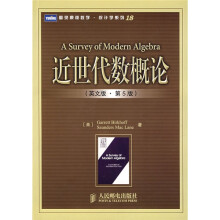近世代数概论(英文版)(第5版)

Preface to the Fourth Edition
1 The Integers
1.1 Commutative Rings; Integral Domains
1.2 Elementary Properties of Commutative Rings
1.3 Ordered Domains
1.4 Well-Ordering Principle
1.5 Finite Induction; Laws of Exponents
1.6 ivisibility
1.7 The Euclidean Algorithm
1.8 Fundamental Theorem of Arithmetic
1.9 Congruences
1.10 The Rings Zn
1.11 Sets, Functions, and Relations
1.12 Isomorphisms and Automorphisms
2 Rational Numbers and Fields
2.1 Definition of a Field
2.2 Construction of the Rationals
2.3 Simultaneous Linear Equations
2.4 Ordered Fields
2.5 Postulates for the Positive Integers
2.6 Peano Postulates
3 Polynomials
3.1 Polynomial Forms
3.2 Polynomial Functions
3.3 Homomorphisms of Commutative Rings
3.4 Polynomials in Several Variables
3.5 The Division Algorithm
3.6 Units and Associates
3.7 Irreducible Polynomials
3.8 Unique Factorization Theorem
3.9 Other Domains with Unique Factorization
3.10 Eisensteins Irreducibility Criterion
3.11 Partial Fractions
4 Real Numbers
4.1 Dilemma of Pythagoras
4.2 Upper and Lower Bounds
4.3 Postulates for Real Numbers
4.4 Roots of Polynomial Equations
4.5 Dedekind Cuts
5 Complex Numbers
5.1 Definition
5.2 The Complex Plane
5.3 Fundamental Theorem of Algebra
5.4 Conjugate Numbers and Real Polynomials
5.5 Quadratic and Cubic Equations
5.6 Solution of Quartic by Radicals
5.7 Equations of Stable Type
6 Groups
6.1 Symmetries of the Square
6.2 Groups of Transformations
6.3 Further Examples
6.4 Abstract Groups
6.5 Isomorphism
6.6 Cyclic Groups
6.7 Subgroups 143
6.8 Lagranges Theorem
6.9 Permutation Groups
6.10 Even and Odd Permutations
6.11 Homomorphisms
6.12 Automorphisms; Conjugate Elements
6.13 Quotient Groups
6.14 Equivalence and Congruence Relations
7 Vectors and Vector Spaces
7.1 Vectors in a Plane
7.2 Generalizations
7.3 Vector Spaces and Subspaces
7.4 Linear Independence and Dimension
7.5 Matrices and Row-equivalence
7.6 Tests for Linear Dependence
7.7 Vector Equations; Homogeneous Equations
7.8 Bases and Coordinate Systems
7.9 Inner Products
7.10 Euclidean Vector Spaces
7.11 Normal Orthogonal Bases
7.12 Quotient-spaces
7.13 Linear Functions and Dual Spaces
8 The Algebra of Matrices
8.1 Linear Transformations and Matrices
8.2 Matrix Addition
8.3 Matrix Multiplication
8.4 Diagonal, Permutation, and Triangular Matrices
8.5 Rectangular Matrices
8.6 Inverses
8.7 Rank and Nullity
8.8 Elementary Matrices 243
8.9 Equivalence and Canonical Form
8.10 Bilinear Functions and Tensor Products
8.11 Quaternions
9 Linear Groups
9.1 Change of Basis
9.2 Similar Matrices and Eigenvectors
9.3 The Full Linear and Affine Groups
9.4 The Orthogonal and Euclidean Groups
9.5 Invariants and Canonical Forms
9.6 Linear and Bilinear Forms
9.7 Quadratic Forms
9.8 Quadratic Forms Under the Full Linear Group
9.9 Real Quadratic Forms Under the Full Linear Group
9.10 Quadratic Forms Under the Orthogonal Group
9.11 Quadrics Under the Affine and Euclidean Groups
9.12 Unitary and Hermitian Matrices
9.13 Affine Geometry
9.14 Projective Geometry
10 Determinants and Canonical Forms
10.1 Definition and Elementary Properties of Determinants
10.2 Products of Determinants
10.3 Determinants as Volumes
10.4 The Characteristic Polynomial
10.5 The Minimal Polynomial
10.6 Cayley-Hamilton Theorem
10.7 Invariant Subspaces and Reducibility
10.8 First Decomposition Theorem
10.9 Second Decomposition Theorem
10.10 Rational and Jordan Canonical Forms
11 Boolean Algebras and Lattices
11.1 Basic Definition
11.2 Laws: Analogy with Arithmetic
11.3 Boolean Algebra
11.4 Deduction of Other Basic Laws
11.5 Canonical Forms of Boolean Polynomials
11.6 Partial Orderings
11.7 Lattices
11.8 Representation by Sets
12 Transfinite Arithmetic
12.1 Numbers and Sets
12.2 Countable Sets
12.3 Other Cardinal Numbers
12.4 Addition and Multiplication of Cardinals
12.5 Exponentiation
13 Rings and Ideals
13.1 Rings
13.2 Homomorphisms
13.3 Quotient-rings
13.4 Algebra of Ideals
13.5 Polynomial Ideals
13.6 Ideals in Linear Algebras
13.7 The Characteristic of a Ring
13.8 Characteristics of Fields
14 Algebraic Number Fields
14.1 Algebraic and Transcendental Extensions
14.2 Elements Algebraic over a Field
14.3 Adjunction of Roots
14.4 Degrees and Finite Extensions
14.5 Iterated Algebraic Extensions
14.6 Algebraic Numbers
14.7 Gaussian Integers
14.8 Algebraic Integers
14.9 Sums and Products of Integers
14.10 Factorization of Quadratic Integers
15 Galois Theory
15.1 Root Fields for Equations
15.2 Uniqueness Theorem
15.3 Finite Fields
15.4 The Galois Group
15.5 Separable and Inseparable Polynomials
15.6 Properties of the Galois Group
15.7 Subgroups and Subfields
15.8 Irreducible Cubic Equations
15.9 Insolvability of Quintic Equations
Bibliography
List of Special Symbols
Index489
1 The Integers
1.1 Commutative Rings; Integral Domains
1.2 Elementary Properties of Commutative Rings
1.3 Ordered Domains
1.4 Well-Ordering Principle
1.5 Finite Induction; Laws of Exponents
1.6 ivisibility
1.7 The Euclidean Algorithm
1.8 Fundamental Theorem of Arithmetic
1.9 Congruences
1.10 The Rings Zn
1.11 Sets, Functions, and Relations
1.12 Isomorphisms and Automorphisms
2 Rational Numbers and Fields
2.1 Definition of a Field
2.2 Construction of the Rationals
2.3 Simultaneous Linear Equations
2.4 Ordered Fields
2.5 Postulates for the Positive Integers
2.6 Peano Postulates
3 Polynomials
3.1 Polynomial Forms
3.2 Polynomial Functions
3.3 Homomorphisms of Commutative Rings
3.4 Polynomials in Several Variables
3.5 The Division Algorithm
3.6 Units and Associates
3.7 Irreducible Polynomials
3.8 Unique Factorization Theorem
3.9 Other Domains with Unique Factorization
3.10 Eisensteins Irreducibility Criterion
3.11 Partial Fractions
4 Real Numbers
4.1 Dilemma of Pythagoras
4.2 Upper and Lower Bounds
4.3 Postulates for Real Numbers
4.4 Roots of Polynomial Equations
4.5 Dedekind Cuts
5 Complex Numbers
5.1 Definition
5.2 The Complex Plane
5.3 Fundamental Theorem of Algebra
5.4 Conjugate Numbers and Real Polynomials
5.5 Quadratic and Cubic Equations
5.6 Solution of Quartic by Radicals
5.7 Equations of Stable Type
6 Groups
6.1 Symmetries of the Square
6.2 Groups of Transformations
6.3 Further Examples
6.4 Abstract Groups
6.5 Isomorphism
6.6 Cyclic Groups
6.7 Subgroups 143
6.8 Lagranges Theorem
6.9 Permutation Groups
6.10 Even and Odd Permutations
6.11 Homomorphisms
6.12 Automorphisms; Conjugate Elements
6.13 Quotient Groups
6.14 Equivalence and Congruence Relations
7 Vectors and Vector Spaces
7.1 Vectors in a Plane
7.2 Generalizations
7.3 Vector Spaces and Subspaces
7.4 Linear Independence and Dimension
7.5 Matrices and Row-equivalence
7.6 Tests for Linear Dependence
7.7 Vector Equations; Homogeneous Equations
7.8 Bases and Coordinate Systems
7.9 Inner Products
7.10 Euclidean Vector Spaces
7.11 Normal Orthogonal Bases
7.12 Quotient-spaces
7.13 Linear Functions and Dual Spaces
8 The Algebra of Matrices
8.1 Linear Transformations and Matrices
8.2 Matrix Addition
8.3 Matrix Multiplication
8.4 Diagonal, Permutation, and Triangular Matrices
8.5 Rectangular Matrices
8.6 Inverses
8.7 Rank and Nullity
8.8 Elementary Matrices 243
8.9 Equivalence and Canonical Form
8.10 Bilinear Functions and Tensor Products
8.11 Quaternions
9 Linear Groups
9.1 Change of Basis
9.2 Similar Matrices and Eigenvectors
9.3 The Full Linear and Affine Groups
9.4 The Orthogonal and Euclidean Groups
9.5 Invariants and Canonical Forms
9.6 Linear and Bilinear Forms
9.7 Quadratic Forms
9.8 Quadratic Forms Under the Full Linear Group
9.9 Real Quadratic Forms Under the Full Linear Group
9.10 Quadratic Forms Under the Orthogonal Group
9.11 Quadrics Under the Affine and Euclidean Groups
9.12 Unitary and Hermitian Matrices
9.13 Affine Geometry
9.14 Projective Geometry
10 Determinants and Canonical Forms
10.1 Definition and Elementary Properties of Determinants
10.2 Products of Determinants
10.3 Determinants as Volumes
10.4 The Characteristic Polynomial
10.5 The Minimal Polynomial
10.6 Cayley-Hamilton Theorem
10.7 Invariant Subspaces and Reducibility
10.8 First Decomposition Theorem
10.9 Second Decomposition Theorem
10.10 Rational and Jordan Canonical Forms
11 Boolean Algebras and Lattices
11.1 Basic Definition
11.2 Laws: Analogy with Arithmetic
11.3 Boolean Algebra
11.4 Deduction of Other Basic Laws
11.5 Canonical Forms of Boolean Polynomials
11.6 Partial Orderings
11.7 Lattices
11.8 Representation by Sets
12 Transfinite Arithmetic
12.1 Numbers and Sets
12.2 Countable Sets
12.3 Other Cardinal Numbers
12.4 Addition and Multiplication of Cardinals
12.5 Exponentiation
13 Rings and Ideals
13.1 Rings
13.2 Homomorphisms
13.3 Quotient-rings
13.4 Algebra of Ideals
13.5 Polynomial Ideals
13.6 Ideals in Linear Algebras
13.7 The Characteristic of a Ring
13.8 Characteristics of Fields
14 Algebraic Number Fields
14.1 Algebraic and Transcendental Extensions
14.2 Elements Algebraic over a Field
14.3 Adjunction of Roots
14.4 Degrees and Finite Extensions
14.5 Iterated Algebraic Extensions
14.6 Algebraic Numbers
14.7 Gaussian Integers
14.8 Algebraic Integers
14.9 Sums and Products of Integers
14.10 Factorization of Quadratic Integers
15 Galois Theory
15.1 Root Fields for Equations
15.2 Uniqueness Theorem
15.3 Finite Fields
15.4 The Galois Group
15.5 Separable and Inseparable Polynomials
15.6 Properties of the Galois Group
15.7 Subgroups and Subfields
15.8 Irreducible Cubic Equations
15.9 Insolvability of Quintic Equations
Bibliography
List of Special Symbols
Index489
Garett Birkhoff(1911-1996)已故世界著名数学家,生前曾任国际数学家大会组织委员会主席、美国数学会副主席,美国工业与应用数学会主席、《大不列颠百科全书》编委,美国科学院院士,哈佛大学教授,1933年开创格论研究,使其成为数学的一个重要分文。
《近世代数概论(英文版)(第5版)》出自近世代数领域的两位科学巨匠之手,是一本经典的教材。全书共分为15章,内容包括:整数、多项式、实数、复数、矩阵代数、线性群、行列式和标准型、布尔代数和格、超限算术、环和理想、代数数域和伽罗华理论等。
《近世代数概论(英文版)(第5版)》曾帮助过几代人理解近世代数,至今仍是一本非常有价值的参考书和教材,适合数学专业及其他理工科专业高年级本科生和研究生使用。
《近世代数概论(英文版)(第5版)》曾帮助过几代人理解近世代数,至今仍是一本非常有价值的参考书和教材,适合数学专业及其他理工科专业高年级本科生和研究生使用。
比价列表
公众号、微信群
 缺书网
缺书网微信公众号
 扫码进群
扫码进群实时获取购书优惠




